Permaculture companion plants for Spinach
| Image | Name | Data | Description | Actions |
|---|---|---|---|---|
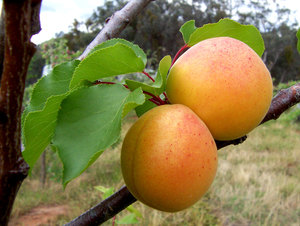
|
Apricot |
4-8
Perennial
Full sun, Partial sun/shade
Moist
Light (sandy), Medium
Deciduous
9.0
Trees
Adhesive, Dye, Gum, oil, Lumber, Espalier
true
Fruit, Seed
https://en.wikipedia.org/wiki/Prunus_armeniaca
Medium
Rosaceae
true
Oil, Gum
https://pfaf.org/User/Plant.aspx?LatinName=Prunus armeniaca
China North-Central, China South-Central, Inner Mongolia, Kazakhstan, Kirgizstan, Kriti, Manchuria, Qinghai, Uzbekistan, Xinjiang
Afghanistan, Albania, Algeria, Bulgaria, California, Central European Rus, Colorado, Corse, Cyprus, East European Russia, East Himalaya, France, Germany, Greece, Hungary, Idaho, Illinois, Iowa, Iran, Italy, Kansas, Korea, Krym, Lebanon-Syria, Libya, Michigan, Missouri, Montana, Morocco, New Mexico, New South Wales, North Caucasus, Oregon, Pakistan, Pennsylvania, Portugal, Queensland, Romania, Sardegna, South Australia, South European Russi, Tadzhikistan, Transcaucasus, Tunisia, Turkey, Turkey-in-Europe, Turkmenistan, Ukraine, Utah, Virginia, Washington, West Himalaya, Yugoslavia
https://powo.science.kew.org/taxon/urn:lsid:ipni.org:names:729463-1
|
The apricot is a tree native to China and Central Asia. It typically grows to be about 20-30 feet tall and has a spreading, round canopy. The leaves are oval-shaped and about 2-4 inches long, with a serrated edge and a glossy green surface. The flowers are white or pink and have five petals. The fruit is a drupe, similar in appearance to a peach, with a smooth, orange skin and a fleshy interior. Apricots are known for their sweet flavor and are often used in jams, jellies, and other preserves. The fruit can also be eaten fresh or dried. The seed, or pit, of the apricot contains a small amount of cyanide and should not be eaten. Apricots prefer a warm, sunny climate and well-draining soil. They are sensitive to frost and can be damaged by cold temperatures. To successfully grow apricots, they should be planted in an area with full sun exposure and watered regularly. Apricots have a number of uses beyond their delicious fruit. The wood of the tree is often used for smoking meats, and the leaves can be used as a natural insecticide. In traditional medicine, apricot oil has been used to treat a variety of ailments. |
Show
Edit |
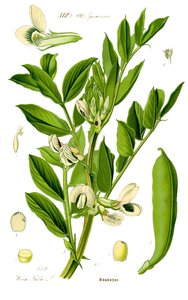
|
Broad Bean |
4-8
Full sun, Partial sun/shade
Moist
Light (sandy), Medium, Heavy (clay)
6.0-6.8
1.0
0.3
Annual
Fast
20cm
Seed - direct sow, Seed - transplant
6 weeks after sowing them in pots
6 weeks after sowing them in pots
21 days
3-5 years
Nitrogen fixer
Leaves, Seed
fava bean, faba bean, Broad bean, or faba bean Varieties with smaller, harder seeds that are fed to horses or other animals are called field bean, tic bean or tick bean Horse bean
Ackerbohne
Fabaceae or Leguminosae
Afghanistan, Iran
Albania, Algeria, Altay, Angola, Argentina South, Assam, Baleares, Bangladesh, Bolivia, Bulgaria, Cameroon, Canary Is., Central European Rus, Chad, China North-Central, China South-Central, China Southeast, Colombia, Corse, Cuba, Cyprus, Czechoslovakia, Dominican Republic, East Aegean Is., East European Russia, Ecuador, Ethiopia, France, Guatemala, India, Iraq, Italy, Jawa, Kenya, Krym, Lebanon-Syria, Leeward Is., Libya, Madeira, Mexico Southwest, Mongolia, Morocco, Myanmar, Nepal, New South Wales, New York, New Zealand North, New Zealand South, Pakistan, Peru, Portugal, Puerto Rico, Rwanda, Sardegna, Sicilia, Spain, Sri Lanka, Sudan, Tibet, Tunisia, Turkey, Turkey-in-Europe, Uruguay, Vermont, Vietnam, West Himalaya, Yemen, Yugoslavia
https://en.wikipedia.org/wiki/Vicia_faba
https://pfaf.org/User/Plant.aspx?LatinName=Vicia faba major
https://powo.science.kew.org/taxon/urn:lsid:ipni.org:names:524737-1
Feb-April; Oct-Nov
sow in deep pots in cool, frost-free place
|
Broad bean (Vicia faba), also known as fava bean or faba bean, is a type of legume that is native to North Africa and the Middle East. It is a popular garden plant, known for its edible beans and attractive purple or white flowers. Broad bean plants have a upright, bushy growth habit and can reach a height of up to 3 feet. The leaves are large and composed of three oval-shaped leaflets, and the flowers are small and clustered in groups of two or three. The beans are produced in long, slender pods that contain two or three beans each. To grow broad beans successfully, it is important to choose a location with well-drained, fertile soil and full sun. The plants should be spaced about 8-12 inches apart, and watered regularly to ensure that the soil stays moist but not waterlogged. Broad beans are generally easy to grow and require little maintenance, but they can be susceptible to pests and diseases, such as aphids and fungal infections. Grows best in temperatures ranging from 60° to 65°F (15-18°C) but will tolerate a range from 40°F (4.4°C) - 75°F (24°C). Broad beans are edible, and the beans can be eaten fresh or frozen, canned or dried for storage. To harvest the beans, the pods should be picked when they are plump and before the beans inside begin to harden. The beans can be removed from the pods by gently squeezing them out. Fresh beans can be stored in the refrigerator for a few days, while dried beans can be stored in an airtight container for several months. In addition to their culinary uses, broad beans also have a number of medicinal properties, and have been used to treat a variety of ailments, including asthma, bronchitis, and anemia. Broad beans are also a valuable food source for many types of wildlife, including birds, insects, and small mammals. The plants provide nectar for bees and other pollinators, and the beans are a popular food for many species of birds. |
Show
Edit |

|
Sweet cherry |
3-7
Perennial
Full sun, Partial sun/shade
Moist
Light (sandy), Medium, Heavy (clay)
Deciduous
18.0
Trees
Dye, Gum, Tannin, Lumber, Espalier
true
Fruit, Seed
https://en.wikipedia.org/wiki/Prunus_avium
Fast
Sweet cherry
Rosaceae
Süßkirsche
https://pfaf.org/User/Plant.aspx?LatinName=Prunus avium
183
Afghanistan, Albania, Algeria, Austria, Belarus, Belgium, Bulgaria, Corse, Cyprus, Czechoslovakia, Denmark, France, Germany, Great Britain, Greece, Hungary, Iran, Ireland, Italy, Krym, Libya, Morocco, Netherlands, North Caucasus, Norway, Poland, Portugal, Romania, Sardegna, Sicilia, Spain, Sweden, Switzerland, Transcaucasus, Tunisia, Turkey, Turkey-in-Europe, Ukraine, Yugoslavia
Arizona, Baleares, Baltic States, British Columbia, California, Central European Rus, Connecticut, Delaware, District of Columbia, East European Russia, East Himalaya, Finland, Idaho, Illinois, Indiana, Kazakhstan, Kentucky, Korea, Maine, Maryland, Massachusetts, Michigan, New Brunswick, New Hampshire, New Jersey, New Mexico, New South Wales, New York, New Zealand North, New Zealand South, North Carolina, Nova Scotia, Ohio, Ontario, Oregon, Pakistan, Pennsylvania, Rhode I., South Australia, South Carolina, South European Russi, Tadzhikistan, Tennessee, Turkmenistan, Utah, Victoria, Virginia, Washington, West Himalaya, West Virginia, Wyoming
3
https://powo.science.kew.org/taxon/urn:lsid:ipni.org:names:30093848-2
Gum
|
The sweet cherry, Prunus avium, is a fruit-bearing tree that is native to Europe, western Asia, and northern Africa. It typically grows to a height of 15-30 feet, with a spread of 20-25 feet, and has a rounded crown. The leaves are oblong-shaped, with serrated edges and a glossy dark green color. The flowers are white or pale pink, with five petals, and appear in clusters in the spring before the leaves. The fruit, which is the sweet cherry, is a small, round drupe, with a smooth, dark red or black skin and a juicy, sweet flesh. In terms of growing conditions, the sweet cherry prefers well-drained, fertile soil and full sun exposure. It can be grown in a variety of climates, but may require protection from frost in harsh climates. To cultivate the sweet cherry successfully, a grower may need to prune the tree to maintain its shape, provide adequate water and fertilizer, and protect the tree from pests and diseases. The sweet cherry is edible and can be eaten fresh or used in a variety of culinary dishes. The fruit can be stored in the refrigerator for a few days or preserved by freezing or canning. The sweet cherry is also valued for its medicinal properties, as the fruit and leaves have been used in traditional medicine to treat a variety of ailments. In terms of its value for wildlife, the sweet cherry provides food for a variety of animals, including birds, squirrels, and other small mammals. It also provides shelter and habitat for these animals. |
Show
Edit |
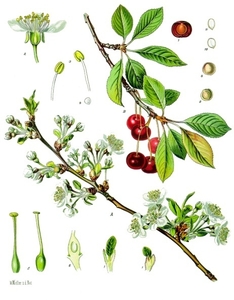
|
Sour cherry |
https://en.wikipedia.org/wiki/Prunus_cerasus
true
Moist
Full sun, Partial sun/shade
3-7
Trees
Light (sandy), Medium, Heavy (clay)
Rosaceae
6.0
Sauerkirsche
Oil, Gum, Tea
Fruit, Seed
Adhesive, Dye, Gum, Hedgerow, oil, Lumber
Perennial
Deciduous
https://pfaf.org/User/Plant.aspx?LatinName=Prunus cerasus
North Caucasus
Afghanistan, Alaska, Argentina South, Austria, Baltic States, Belgium, British Columbia, Bulgaria, California, Central European Rus, Connecticut, Czechoslovakia, Delaware, District of Columbia, East European Russia, East Himalaya, France, Georgia, Germany, Great Britain, Hungary, Idaho, Illinois, Indiana, Iowa, Iran, Ireland, Irkutsk, Italy, Kansas, Kazakhstan, Kentucky, Korea, Madeira, Maine, Maryland, Massachusetts, Michigan, Missouri, Montana, Nebraska, New Brunswick, New Hampshire, New Jersey, New Mexico, New South Wales, New York, New Zealand North, New Zealand South, North Carolina, Nova Scotia, Ohio, Ontario, Oregon, Pakistan, Pennsylvania, Poland, Portugal, Prince Edward I., Québec, Rhode I., Sardegna, Sicilia, South European Russi, Spain, Sweden, Switzerland, Tadzhikistan, Transcaucasus, Turkey, Turkmenistan, Ukraine, Uzbekistan, Vermont, Virginia, Washington, West Himalaya, West Siberia, West Virginia, Xinjiang, Yugoslavia
https://powo.science.kew.org/taxon/urn:lsid:ipni.org:names:729574-1
|
Show
Edit |
|

|
Nectarine |
4-8
Perennial
Full sun
Moist
Light (sandy), Medium, Heavy (clay)
Deciduous
6.0
Trees
Adhesive, Cleanser, Dye, Gum, oil, Espalier
true
Flowers, Fruit, Seed
Rosaceae
Nektarine
Oil, Gum, Tea
https://pfaf.org/User/Plant.aspx?LatinName=Prunus persica nucipersica
Nectarine
Nektarin
3
|
Nectarine (Prunus persica nucipersica) is a plant that is a type of stone fruit. It is native to China and is closely related to the peach. Nectarines are similar in appearance to peaches, but have smooth skin rather than fuzzy skin. They can range in size from small to large and are typically round or oval in shape. Nectarines have green or red leaves and white or pink flowers. The stems of the plant are generally thin and have thorns. Nectarines can grow to be quite large, reaching heights of up to 8 meters. They grow best in warm, sunny climates and well-drained soil. To cultivate nectarines successfully, a grower will need to provide the plant with plenty of sunlight and water. They may also need to prune the plant to maintain its shape and encourage new growth. Nectarines are edible and the fruit can be eaten fresh or cooked. The edible parts of the fruit can be stored in a cool, dry place after harvest. Nectarines have several uses. In addition to being eaten fresh or cooked, they can also be used to make jams, jellies, and other preserves. They can also be dried and used as a snack. In addition to their culinary uses, nectarines have been used medicinally for their high vitamin and mineral content. They are also valued for their ability to attract wildlife, such as birds and bees, to the garden. |
Show
Edit |

|
Peach |
5-9
Perennial
Full sun
Moist
Light (sandy), Medium, Heavy (clay)
6
Trees
true
Flowers, Fruit, Seed
https://en.wikipedia.org/wiki/Peach
Fast
Flowering peach, ornamental peach, common peach
Rosaceae
Pfirsich, bergpfirsich, tellerpfirsich, saturnpfirsich, weinbergpfirsich
Oil, Gum, Tea
https://pfaf.org/User/Plant.aspx?LatinName=Prunus persica
China North-Central
Afghanistan, Alabama, Argentina Northwest, Arizona, Arkansas, Assam, Baleares, Bulgaria, California, Cape Verde, China South-Central, China Southeast, Colorado, Connecticut, Corse, Cyprus, Delaware, District of Columbia, East European Russia, East Himalaya, Ecuador, El Salvador, Ethiopia, Florida, France, Free State, Georgia, Greece, Hungary, Idaho, Illinois, India, Indiana, Iowa, Iran, Italy, Japan, Kansas, Kazakhstan, Kentucky, Kenya, Kirgizstan, Korea, Kriti, Krym, KwaZulu-Natal, Laos, Libya, Louisiana, Maine, Marianas, Maryland, Massachusetts, Mauritius, Michigan, Mississippi, Missouri, New Jersey, New Mexico, New South Wales, New York, New Zealand North, North Carolina, North Caucasus, Northern Provinces, Nova Scotia, Ohio, Oklahoma, Ontario, Oregon, Pakistan, Pennsylvania, Portugal, Queensland, Rhode I., Rodrigues, Romania, Réunion, Sardegna, South Australia, South Carolina, South European Russi, St.Helena, Switzerland, Tadzhikistan, Tennessee, Texas, Transcaucasus, Turkey, Turkmenistan, Ukraine, Utah, Uzbekistan, Vietnam, Virginia, West Himalaya, West Virginia, Wisconsin
3
https://powo.science.kew.org/taxon/urn:lsid:ipni.org:names:1212858-2
Adhesive, Cleanser, Dye, Gum, oil, Espalier
|
The peach, scientifically known as Prunus persica, is a deciduous tree native to northwest China. It typically grows to be about 10-30 feet tall, with a short trunk and a rounded crown. The leaves are oval-shaped, with serrated edges and a glossy, dark green color. The flowers are pink and white, with five petals each. Peaches are known for their fuzzy, peach-colored skin and juicy, sweet flesh. They can be eaten fresh, canned, or cooked into dishes such as pies and cobblers. The edible parts of the peach include the flesh and the seed, which contains a small kernel that can be ground into flour. Peaches can be stored after harvest by keeping them in a cool, dry place. Peaches prefer well-draining, loamy soil and full sun. They can be grown in a variety of climates, but do best in warm, temperate regions. To cultivate peaches successfully, growers may need to provide support for the trees, prune them regularly, and protect them from pests and diseases. Peaches are generally winter hardy, but can be damaged by frost. In addition to being eaten fresh, peaches have a variety of uses. The flowers can be used in herbal teas, and the leaves can be used to make a yellow dye. The wood of the tree can be used for smoking meat, and the kernels can be used to make oil. Peaches are also a valuable food source for wildlife, attracting birds, squirrels, and other animals. |
Show
Edit |

|
Marjoram |
6-9
Perennial
Full sun, Partial sun/shade
Dry, Moist
Light (sandy), Medium, Heavy (clay)
0.6
Herbs
true
Leaves
https://en.wikipedia.org/wiki/Marjoram
Lamiaceae or labiatae
Majoran
https://pfaf.org/User/Plant.aspx?LatinName=Origanum majorana
Cyprus, Turkey
Algeria, Azores, Baleares, Baltic States, Corse, Czechoslovakia, Great Britain, Greece, India, Italy, Juan Fernández Is., Krym, Libya, Madeira, Morocco, Spain, Switzerland, Tunisia, Ukraine, Venezuela, Yugoslavia
https://powo.science.kew.org/taxon/urn:lsid:ipni.org:names:453303-1
Condiment, Tea
Disinfectant, Dye, Essential Oil, Fragrance
|
Marjoram (Origanum majorana) is a herbaceous plant that is native to the Mediterranean region. It has delicate, oval-shaped leaves that are pale green in color, and small white or pink flowers that grow in clusters. The plant grows to a height of about 30 cm and has a woody stem. In terms of growing conditions, marjoram prefers well-drained, light soil and full sun to partial shade. It can be grown from seeds or cuttings, and should be spaced about 30 cm apart. Marjoram is winter hardy in mild climates, but may need to be protected or brought indoors in colder regions. Marjoram has a number of culinary uses. It is often used as a flavoring in soups, stews, and sauces, and can be added to salads and other dishes as a garnish. The leaves and flowers of the plant are edible and can be used fresh or dried. When harvesting marjoram, it is best to pick the leaves early in the morning when they are at their most flavorful. The leaves can be stored in an airtight container in a cool, dark place for up to six months. In addition to its culinary uses, marjoram has also been used medicinally as an antiseptic and as a remedy for digestive problems. It is also sometimes used in perfumes and soaps. Marjoram is not particularly attractive to wildlife, but it can provide habitat for some beneficial insects such as bees and butterflies. |
Show
Edit |
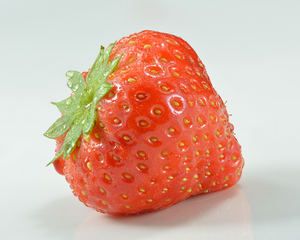
|
Strawberry |
4-8
Perennial
Full sun, Partial sun/shade
Moist
Light (sandy), Medium, Heavy (clay)
0.3
Herbs
Ground cover
True
Fruit, Leaves
https://en.wikipedia.org/wiki/Strawberry
Rosaceae
Erdbeere
https://pfaf.org/User/Plant.aspx?LatinName=Fragaria x ananassa
Aardbei
Jordbær
British Columbia, California, Oregon, Washington
Albania, Baltic States, Belarus, Central European Rus, Denmark, East European Russia, El Salvador, Finland, France, Germany, Great Britain, Guatemala, Honduras, Illinois, Ireland, Italy, Japan, Korea, Netherlands, New York, North European Russi, Northwest European R, Norway, Pitcairn Is., South European Russi, Sweden, Switzerland, Tadzhikistan, Turkey, Turkmenistan, Vermont
0.3
https://powo.science.kew.org/taxon/urn:lsid:ipni.org:names:30117681-2
|
Strawberry (Fragaria × ananassa) is a popular fruit-bearing plant that is native to parts of the Americas, Europe, and Asia. It is a member of the Rosaceae family and is closely related to other fruit-bearing plants such as raspberries and blackberries. The plant has a low-growing, spreading habit, with leaves that are typically green and glossy, and white flowers that give way to red, juicy berries. The fruits are edible and are often eaten fresh, used in jams and jellies, or baked in desserts. Strawberry plants prefer well-draining, moist soil and plenty of sunlight. They can be grown in a variety of climates, but they tend to thrive in temperate regions with cool summers and mild winters. To cultivate the plants successfully, a grower may need to provide adequate irrigation, fertilizer, and pest control. One of the distinctive features of strawberry plants is their runners, which are long, slender stems that grow horizontally along the ground. These runners can be used to propagate new plants, which can be grown in rows or beds to form a dense, ground-covering mat. In addition to their value as a food source, strawberry plants are also prized for their attractiveness to pollinators and other beneficial insects. They are often used in home gardens and on small farms as a way to attract bees, butterflies, and other insects that help to pollinate other plants. Overall, strawberries are a versatile and valuable plant that is prized by gardeners and farmers alike for their delicious fruit and their ability to attract wildlife. |
Show
Edit |

|
Cauliflower |
3-10
Full sun, Partial sun/shade
Moist
Light (sandy), Medium, Heavy (clay)
0.8
Annual, Biennial
3-7 years
Companion, antifungal, Dynamic accumulator
true
Flowers, Leaves
Blumenkohl
Brassicaceae or cruciferae
https://pfaf.org/User/Plant.aspx?LatinName=Brassica oleracea botrytis
|
Annual plant reproduced by seed. |
Show
Edit |

|
Kale |
5-10
Full sun, Partial sun/shade
Moist
Light (sandy), Medium, Heavy (clay)
6.0-6.8
Deciduous
0.9
Biennial, Perennial
Herbs
Fast
45cm
Seed - direct sow, Seed - transplant
At last frost date
4-6 weeks before last frost
7-10 days
3 to 7 years
Dynamic accumulator
true
Shoots
Brassicaceae, Cruciferae
True
https://en.wikipedia.org/wiki/Kale
https://pfaf.org/User/Plant.aspx?LatinName=Brassica oleracea acephala
Shallow
0.5 cm
60
|
Kale (/keɪl/) is a hardy, leafy green vegetable that is a member of the Brassica oleracea species. It is native to the eastern Mediterranean and Asia Minor, and has been cultivated for food for over 2000 years. Kale plants typically have green or purple leaves that are deeply lobed and can grow up to 2 feet in length. The leaves are attached to a central stem and don't make a head, and the plant produces small, yellow flowers. Kales are considered to be closer to wild cabbage than most of the many domesticated forms of Brassica oleracea. In terms of growing conditions, kale prefers cool weather and does well in full sun to partial shade. It can be grown year-round in mild climates, but in colder climates it is best grown in the fall and early spring. To cultivate kale successfully, it is important to provide the plants with plenty of moisture and to regularly fertilize them. Kale is also a good companion plant for other vegetables, as it can help to deter pests and improve the health of the soil. In terms of edibility, kale is highly nutritious and can be eaten raw or cooked. The leaves and stems are both edible, and the plant can be stored in the refrigerator for several days after harvest. Kale can be used in a variety of dishes, including soups, salads, and smoothies. It can also be cooked and served as a side dish, or used as a garnish. In addition to its culinary uses, kale has a number of other uses. It is often used as a cover crop, as it can help to improve the fertility of the soil. Kale leaves can also be used as a mulch, as they break down readily and release nutrients into the soil. Additionally, kale plants can be used for wind protection, as their large leaves and sturdy stems can provide a barrier to wind. ### Links [Kale @ West Coast Seeds](https://www.westcoastseeds.com/blogs/how-to-grow/grow-kale-collards) |
Show
Edit |

|
Apple |
3-8
Full sun, Partial sun/shade
Moist
Light (sandy), Medium, Heavy (clay)
Deciduous
10.0
9
Perennial
Trees
Animal feed, Attracts insects, Hedgerow
True
Fruit
Oil
Appel
Æble
Rosaceae
Malus
Afghanistan, Kazakhstan, Kirgizstan, Pakistan, Tadzhikistan, Uzbekistan, Xinjiang
Alabama, Alaska, Albania, Argentina Northeast, Argentina South, Arkansas, Azores, Baleares, Baltic States, Belarus, Belgium, British Columbia, Bulgaria, California, Central European Rus, Colorado, Connecticut, Cyprus, Czechoslovakia, Delaware, Denmark, District of Columbia, East European Russia, East Himalaya, Ecuador, Falkland Is., Finland, France, Georgia, Germany, Great Britain, Greece, Hungary, Illinois, Indiana, Iowa, Iraq, Ireland, Italy, Kansas, Kentucky, Korea, Krym, Louisiana, Madeira, Maine, Manitoba, Maryland, Massachusetts, Michigan, Minnesota, Mississippi, Missouri, Montana, Nebraska, Nepal, Netherlands, Nevada, New Brunswick, New Hampshire, New Jersey, New Mexico, New South Wales, New York, Newfoundland, North Carolina, North Caucasus, North Dakota, Norway, Nova Scotia, Ohio, Ontario, Oregon, Pennsylvania, Poland, Prince Edward I., Québec, Rhode I., Romania, South Carolina, South European Russi, Spain, Sweden, Tasmania, Tennessee, Turkmenistan, Ukraine, Utah, Vermont, Victoria, Virginia, West Virginia, Wisconsin, Wyoming, Yugoslavia
https://en.wikipedia.org/wiki/Apple
https://pfaf.org/user/plant.aspx?LatinName=Malus+domestica
https://powo.science.kew.org/taxon/urn:lsid:ipni.org:names:726282-1
Apfel
|
An apple is an edible fruit produced by an apple tree (Malus domestica). Apple trees are cultivated worldwide and are the most widely grown species in the genus Malus. The tree originated in Central Asia, where its wild ancestor, Malus sieversii, is still found today. Apples have been grown for thousands of years in Asia and Europe and were brought to North America by European colonists. Apples have religious and mythological significance in many cultures, including Norse, Greek, and European Christian tradition. Apples grown from seed tend to be very different from those of their parents, and the resultant fruit frequently lacks desired characteristics. Generally, apple cultivars are propagated by clonal grafting onto rootstocks. Apple trees grown without rootstocks tend to be larger and much slower to fruit after planting. Rootstocks are used to control the speed of growth and the size of the resulting tree, allowing for easier harvesting. There are more than 7,500 known cultivars of apples. Different cultivars are bred for various tastes and uses, including cooking, eating raw, and cider production. Trees and fruit are prone to a number of fungal, bacterial, and pest problems, which can be controlled by a number of organic and non-organic means. In 2010, the fruit's genome was sequenced as part of research on disease control and selective breeding in apple production. Worldwide production of apples in 2018 was 86 million tonnes, with China accounting for nearly half of the total. From [Wikipedia](https://en.wikipedia.org/wiki/Apple) |
Show
Edit |
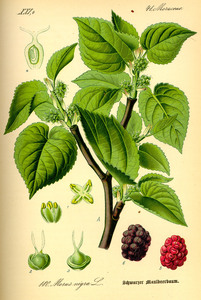
|
Black mulberry |
5-9
Full sun, Partial sun/shade
Moist
Light (sandy), Medium, Heavy (clay)
Deciduous
10.0
4.5
Perennial
Trees
Slow
Dye, Fiber, Lumber
true
Fruit, Shoots
Mulberry, Morus species
Schwarze maulbeere
Moraceae
Iran
Afghanistan, Albania, Algeria, Bermuda, Bulgaria, Canary Is., Cuba, Greece, India, Iraq, Italy, Kazakhstan, Kirgizstan, Kriti, Lebanon-Syria, Leeward Is., Libya, Madeira, Morocco, Puerto Rico, Romania, Spain, Tadzhikistan, Transcaucasus, Tunisia, Turkey, Turkmenistan, Uzbekistan, Vietnam, West Himalaya, Windward Is., Xinjiang
https://en.wikipedia.org/wiki/Morus_nigra
https://pfaf.org/User/Plant.aspx?LatinName=Morus nigra
https://powo.science.kew.org/taxon/urn:lsid:ipni.org:names:854688-1
|
The black mulberry (Morus nigra) is a species of mulberry native to southwestern Asia, including Iran, Afghanistan, and Pakistan. It is a small to medium-sized tree that grows to be about 20-30 feet tall and has a round, dense canopy. The leaves of the black mulberry are dark green and glossy on the top, and paler and slightly hairy on the bottom. The tree produces small, white flowers in the spring, which are followed by black, juicy fruits in the summer. The black mulberry is relatively fast-growing and can reach its full size in about 10-15 years. It prefers well-drained, fertile soil and full sun, but can tolerate partial shade. It is also winter hardy and can withstand temperatures down to about -10°F. The fruits of the black mulberry are edible and can be eaten fresh or used in jams, jellies, and other preserves. They can also be dried and stored for later use. The leaves of the black mulberry can be fed to silkworms, and the wood of the tree is strong and durable, making it suitable for a variety of uses. In addition to its edible fruits, the black mulberry has several other uses. Its leaves can be used as a natural fertilizer, and the tree can provide shade and wind protection in gardens and farms. The black mulberry is also a popular food source for birds and other wildlife. |
Show
Edit |
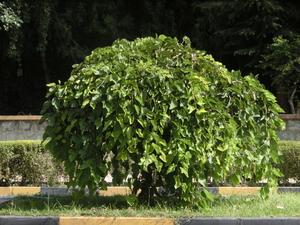
|
White mulberry |
3-9
Full sun, Partial sun/shade
Moist
Light (sandy), Medium, Heavy (clay)
Deciduous
18
13
Perennial
Trees
Medium
Biomass, Dye, Fiber, Animal feed, Wind breaker, Tannin, Lumber
true
Fruit, Inner bark, Leaves, Shoots
Common mulberry
Weiße Maulbeere
Moraceae
Angola, Benin, Cameroon, Central African Repu, Congo, Equatorial Guinea, Gabon, Ghana, Guinea, Guinea-Bissau, Ivory Coast, Kenya, Liberia, Mauritania, Namibia, Nigeria, Senegal, Sierra Leone, Tanzania, Uganda, Zaïre
https://en.wikipedia.org/wiki/Morus_alba
https://pfaf.org/User/Plant.aspx?LatinName=Morus alba
https://powo.science.kew.org/taxon/urn:lsid:ipni.org:names:547653-1
Weed potential
Manna, Tea
|
The white mulberry is a deciduous tree native to northern China, Korea, and Japan. It has large, heart-shaped leaves and small, white or pale pink flowers that grow in clusters. The tree can grow to be quite large, up to 50 feet tall, and it is fast-growing. White mulberry trees can be differentiated from other mulberry trees by their white, rather than dark purple, fruit. White mulberry trees prefer well-draining soil and full sun, but can tolerate partial shade. They are drought-tolerant and can thrive in a variety of soil types. In colder climates, they may need to be protected from frost during the winter months. The fruit of the white mulberry tree is edible and is often used to make jams, jellies, and wines. The fruit can be stored by freezing or canning. Young leaves can also be eaten. White mulberry trees are valued for their fast growth and ability to provide shade. They can be used for wind protection and as a ground cover. The leaves of the tree are sometimes used as animal feed. In some cultures, the bark of the white mulberry tree is used medicinally. Leaves are not frost resistant. |
Show
Edit |
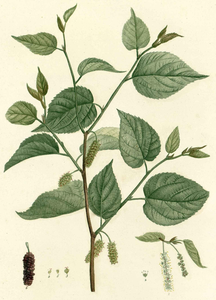
|
Red mulberry |
4-9
Full sun, Partial sun/shade
Moist
Light (sandy), Medium, Heavy (clay)
15.0
4.5
Perennial
Trees
true
Fruit, Leaves, Shoots
Common mulberry, white mulberry
Rote maulbeere
Moraceae
Alabama, Arkansas, Connecticut, District of Columbia, Florida, Georgia, Illinois, Indiana, Iowa, Kansas, Kentucky, Louisiana, Maryland, Massachusetts, Michigan, Minnesota, Mississippi, Missouri, Nebraska, New Jersey, New York, North Carolina, Ohio, Oklahoma, Ontario, Pennsylvania, Rhode I., South Carolina, Tennessee, Texas, Vermont, Virginia, West Virginia, Wisconsin
Bermuda, New Mexico, Turkey, Turkey-in-Europe
https://en.wikipedia.org/wiki/Morus_rubra
https://pfaf.org/User/Plant.aspx?LatinName=Morus rubra
https://powo.science.kew.org/taxon/urn:lsid:ipni.org:names:854710-1
1.5
Fiber, Lumber
|
The Red mulberry, Morus rubra, is native to the eastern United States and Canada. It is a deciduous tree that can grow to a height of up to 80 feet. The leaves are dark green and have a rough texture. The tree produces small, greenish-white flowers in the spring, which develop into clusters of red berries in the summer. The Red mulberry is often differentiated from other mulberry species by its smaller leaves and red berries. It prefers well-drained, moist soil and partial to full sun exposure. It is winter hardy and does not require any special care or maintenance. The fruit of the Red mulberry is edible and can be eaten fresh or used in cooking and baking. The berries can be stored in the refrigerator for up to a week. The tree also has a number of medicinal uses, including as a laxative and for treating sore throat and bronchitis. In terms of wildlife, the Red mulberry is a valuable food source for a variety of birds and mammals. Its fruit is a popular food source for birds such as robins, mockingbirds, and blue jays. The tree also provides habitat for birds and small mammals. |
Show
Edit |
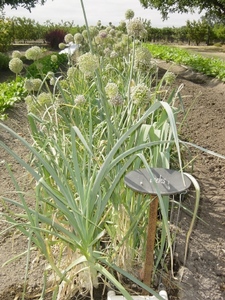
|
Allium porrum |
5-9
Full sun
Moist
Light (sandy), Medium
0.9
Herbs
Pest control, Repels carrot rust flies
Flowers, Leaves, Root
Seed - transplant
https://en.wikipedia.org/wiki/Leek
Garden leek
Alliaceae, Liliaceae
https://pfaf.org/User/Plant.aspx?LatinName=Allium porrum
sow indoors in containers from Feb., transplant early summer
15cm
Feb. - April
6.0-6.5
< 65°F
Albania, Algeria, Baleares, Bulgaria, Cyprus, East Aegean Is., Egypt, Ethiopia, France, Greece, Iran, Iraq, Italy, Kriti, Lebanon-Syria, Libya, Morocco, Palestine, Portugal, Romania, Sardegna, Sicilia, Sinai, Spain, Transcaucasus, Tunisia, Turkey, Turkey-in-Europe, Turkmenistan, Uzbekistan, Yugoslavia
Alabama, Argentina Northeast, Azores, Baltic States, Belarus, California, Canary Is., Central European Rus, Cuba, Czechoslovakia, Dominican Republic, East European Russia, Galápagos, Great Britain, Haiti, Illinois, Ireland, Kentucky, Madeira, Mexico Central, Mexico Northeast, Mexico Northwest, Mexico Southeast, Mexico Southwest, New South Wales, New York, North European Russi, Northwest European R, Pakistan, Puerto Rico, South Australia, South European Russi, Tasmania, Tennessee, Texas, Ukraine, Victoria, Western Australia
Allium ampeloprasum
https://powo.science.kew.org/taxon/urn:lsid:ipni.org:names:332079-2
May - July
0.15
https://powo.science.kew.org/taxon/urn:lsid:ipni.org:names:528646-1
true
|
The leek is a member of the onion family. It is native to the eastern Mediterranean and parts of Asia. The plant has long, flat, glossy leaves that are typically green in color. It has a white stem that widens into a bulb at the bottom. The plant has a distinctive, onion-like aroma and flavor. Leek plants grow to a height of around one to two feet and have a spread of six to eight inches. They grow relatively slowly, taking around three to four months to reach maturity. Leeks can be distinguished from other members of the onion family by their larger size and more elongated shape. Leek plants prefer moist, well-drained soil and full sun. They can be grown in a variety of soil types but prefer a slightly alkaline pH. To cultivate leeks successfully, a grower should plant them in trenches or hills and keep the soil moist throughout the growing season. Leeks are winter hardy and can be grown in most climates. Usually sown in containers or seed beds first and then moved to their final place a few months later. Leeks are edible and can be used in a variety of dishes. The edible parts of the plant are the white stem and the tender inner leaves. Leeks can be stored in the refrigerator for several weeks after harvest. In addition to their use in cooking, leeks have a number of other uses. They can be used medicinally to treat a variety of conditions, including coughs and respiratory problems. |
Show
Edit |